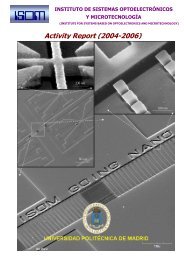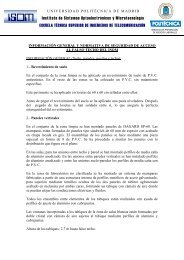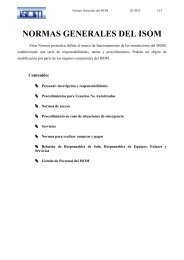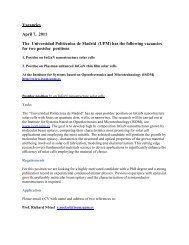Graphene-on-SiC - ISOM
Graphene-on-SiC - ISOM
Graphene-on-SiC - ISOM
You also want an ePaper? Increase the reach of your titles
YUMPU automatically turns print PDFs into web optimized ePapers that Google loves.
TECHNOLOGY GaN POWER ELECTRONICS<br />
Figure 3. Material<br />
theoretical limits and a<br />
plot of R <strong>on</strong><br />
verses reverse<br />
breakdown voltage<br />
for various field plate<br />
geometries<br />
Figure 4. Lateral ACFP<br />
GaN Schottky diode<br />
reverse breakdown as<br />
a functi<strong>on</strong> of anode to<br />
cathode spacing<br />
another opportunity for GaN-<strong>on</strong>-silic<strong>on</strong> is in<br />
electric cars, including hybrid, plug-in, and fuel<br />
cell designs. These vehicles have roadmaps<br />
though 2014 to push to a 2 kv operating bus,<br />
a move that will reduce <strong>on</strong>-state and switching<br />
losses and boost efficiency. The latter gain is<br />
highly beneficial, because it eliminates the need<br />
for a cooling loop for inverter circuitry, it increases<br />
battery life, and it delivers savings in terms of<br />
weight, volume and cost. Efficiency gains resulting<br />
from higher voltage-handling capabilities also<br />
make it attractive to deploy GaN-<strong>on</strong>-silic<strong>on</strong> devices<br />
in industrial drives, electric trains, and military and<br />
merchant fleet applicati<strong>on</strong>s. our low cost GaN<strong>on</strong>-silic<strong>on</strong><br />
technology has the potential to target<br />
all of these applicati<strong>on</strong>s. It is based <strong>on</strong> the use of<br />
commercial GaN-<strong>on</strong>-silic<strong>on</strong> epitaxy, and involves<br />
HEMTs with an alGaN buffer and barrier layer (see<br />
Figure 1).<br />
These structures can be grown by either MoCvD<br />
or MBE, using a process that begins with the<br />
depositi<strong>on</strong> of a nucleati<strong>on</strong> layer that is unique to<br />
the starting substrate material (either silic<strong>on</strong>, <strong>SiC</strong>,<br />
or sapphire high-resistivity substrates). a relatively<br />
thick alGaN buffering layer or super-lattice<br />
structure is then deposited <strong>on</strong>to the nucleati<strong>on</strong><br />
layer. This serves two purposes: It mitigates lattice<br />
mismatch and induced strain associated with<br />
the substrate/epitaxy transiti<strong>on</strong>; and it provides<br />
electrical isolati<strong>on</strong> of the active device regi<strong>on</strong> from<br />
the substrate and substrate/epitaxy interface.<br />
Leakage from this buffer, which ultimately sets the<br />
limit for the overall device reverse breakdown, is<br />
determined by the compositi<strong>on</strong> and total thickness<br />
of the buffering layer.<br />
after the buffer has been deposited, growth<br />
c<strong>on</strong>tinues with the additi<strong>on</strong> of the active GaN and<br />
alGaN Schottky barrier layers. The aluminium<br />
fracti<strong>on</strong>al c<strong>on</strong>tent in this barrier is generally between<br />
22 percent and 32 percent, with the precise value<br />
chosen to deliver the best compromise between<br />
<strong>on</strong>-resistance and leakage characteristics. a<br />
GaN cap often completes the structure. This<br />
reduces oxidati<strong>on</strong> of the underlying alGaN film and<br />
improves the device’s c<strong>on</strong>tact resistance.<br />
We are by no means the <strong>on</strong>ly developers of<br />
GaN-<strong>on</strong>-silic<strong>on</strong> technology, but the efforts of most<br />
groups in this field have been limited to 600 v<br />
applicati<strong>on</strong>s. This focus has led many within the<br />
power electr<strong>on</strong>ics industry to incorrectly believe<br />
that GaN-<strong>on</strong>-silic<strong>on</strong> devices are limited to this<br />
operating range, and GaN single-ended devices<br />
must be built <strong>on</strong> <strong>SiC</strong> if they are to deliver voltage<br />
stand-off capabilities above 1 kv. We have no<br />
doubts that GaN-<strong>on</strong>-<strong>SiC</strong> devices can operate at 1<br />
kv and more, but they are prohibitively expensive<br />
– and we can’t see that changing. our missi<strong>on</strong> is<br />
to address the misc<strong>on</strong>cepti<strong>on</strong>s regarding the limits<br />
of GaN-<strong>on</strong>-silic<strong>on</strong> technology, and show that it is<br />
capable of creating high-blocking-voltage devices<br />
capable of carrying high currents.<br />
Thanks to recent advances in commercial GaN<strong>on</strong>-silic<strong>on</strong><br />
epitaxy – especially in the c<strong>on</strong>structi<strong>on</strong><br />
of advanced buffer layers coupled with field plate<br />
design technology – HEMTs and Schottky diodes<br />
can now deliver standoff voltages in excess of<br />
1.5 kv. Devices made by us can even hit much<br />
higher values than this, with GaN-<strong>on</strong>-silic<strong>on</strong><br />
HEMTs producing blocking voltages in excess<br />
of 2.5 kv, and Schottky diodes incorporating<br />
the same materials technology delivering standoff<br />
voltages of more than 3 kv. These levels of<br />
performance are rebuffing the accepted wisdom<br />
that GaN devices must be built <strong>on</strong> <strong>SiC</strong>, if they are<br />
to serve power electr<strong>on</strong>ics applicati<strong>on</strong>s requiring<br />
enhanced voltage operati<strong>on</strong>.<br />
our results include a portfolio of devices<br />
combining 1.5 kv blocking voltages with current<br />
handling capabilities in excess of 10 a. These<br />
44 www.compoundsemic<strong>on</strong>ductor.net April/May 2013











